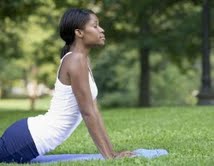Guest Post
Yoga means something different for everyone: for some people, it is an opportunity to unwind, relax, and find balance; for others, it is a means of healing through strength, flexibility, and focus. For many, it simply means putting on yoga pants with the intent of doing yoga.
If you are new to yoga, it is natural to feel a little silly, even intimidated—the positions don’t feel natural at first, and experienced yogis make difficult and complex poses look as easy as 1-2-3. And while these experts have spent years of disciplined exercise shaping their bodies and minds, even they at one time were beginners. Yoga is a wonderful opportunity to bring a stressful life into balance; just remember a few important tips.
1. Wear Comfortable Clothes
So, yes, they are called yoga pants for a reason; however, almost any clothing without the word “yoga” in front of it will also be appropriate. When selecting your new yoga wardrobe, look for the following qualities in the fabric:
-
Lightweight: Yoga is just as much a physical challenge as it is a mental and spiritual one. Consequently, you will likely sweat from physical exertion. Make sure your clothing is lightweight and breathable to help you stay dry and comfortable.
-
Flexible: While many of us may not be terribly flexible, our yoga clothing should be. This will allow you to literally stretch your physical limits as you bring your body and spirit into harmony. Avoid practicing yoga in jeans or other material that restricts movement.
-
Form-Fitting: It can be easy to feel self-conscious while practicing yoga, especially if you’re a beginner. However, clothing that is too loose or requires persistent tugging and adjusting can distract you from your goal.
2. Give Yourself Enough Time
Adopting a new lifestyle or hobby will require you to adjust your current routine, and the process of becoming a yoga expert is no different. Just remember not to rush your yoga session, as feeling rushed will invite feelings of stress and anxiety and will be counterproductive to your goal of balance and enlightenment. While truly mastering certain yoga techniques can be quite time consuming, other techniques take very little time
-
Meditation: You don’t need hours to properly meditate. In fact, useful, meaningful meditation can be completed in a matter of five to 10 minutes. Just remember to free yourself from all distraction—cell phone, computer, people, etc.—and you could even meditate at your work desk!
-
Stretching: Some sessions can take up to 45 minutes or more to complete; however, if you have a problem area you’d like to focus on, you can do a specialized session in less time.
3. Learn to Breath Correctly
The average person takes a breath approximately 30,000 times each day (and unconsciously at that), yet very few of us take the time to learn how to breath effectively. Proper breathing, both in yoga and throughout the day, provides an optimum level of oxygen to our bloodstream while using the least amount of energy. This in turn allows us to feel more awake and relaxed, and less stressed.
-
Posture: Whether you’re sitting, standing, or lying down, keep your back straight, shoulders relaxed, and your chest and abdomen open. This will allow for unobstructed airflow.
-
Inhalation: Inhale slowly through your nose, taking in as much air as you can. You should feel like your chest and abdomen are inflating.
-
Exhalation: Take a short pause before exhaling to allow your body to enjoy the new air. Then, slowly exhale through your nose until you need to take another breath.
4. Find a Focal Point
Many people have the false belief that true relaxation involves sitting motionless in front of a television, eyes mindlessly fixed on the bright lights and flashing colors. However, true relaxation requires total focus, especially in yoga. During your sessions, find a positive focal point for your mind as well as your eyes:
-
Concepts: Words like “peace”, “truth”, or “love” not only affect us emotionally, but they can also affect us physically by relaxing our muscles and increasing blood flow.
-
Sounds: Occasionally, playing relaxing music or listening to the voice of your instructor can be a great focal point.
5. Strive for Consistent Improvement
Above all else, strive for consistent improvement. Avoid comparing your progress, or perceived lack of progress, to that of others; your best may not be the same as someone else’s best. Set personal goals that are both challenging and realistic. For example, if you have trouble reaching your toes, work consistently to make that goal a reality. If maintaining a certain pose is difficult for you, look to develop your strength and balance until you perfect it. Remember, these things take time and patience, so don’t become frustrated if you’re not an instant expert.
The great thing about yoga is that anyone can do it. By making the necessary preparations, you can bring your life into harmony and balance, and maybe even use those yoga pants for what they were intended.

